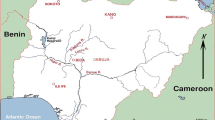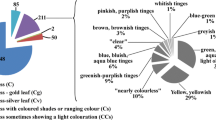Abstract
Glass is unique among the archaeological materials of the Late Bronze Age, in its production, use and social meaning. Emerging as a regularly produced substance in the mid-second millennium BCE almost simultaneously in both Mesopotamia and Egypt, we still know surprisingly little about its origin and the organization of production and distribution to the elite workshops shaping it into colourful objects. However, over the past two decades, the combination of trace element chemical analyses of glass and a reassessment of earlier excavated production debris enabled us to made massive progress in our understanding of this industry, as is summarized in this paper.
Access this chapter
Tax calculation will be finalised at checkout
Purchases are for personal use only
Similar content being viewed by others
References
Brill, R. H. (1999). Chemical analyses of early glasses (Vol. I and II). Corning Museum of Glass.
Dayton, J. (1978). Minerals, metals, glazing and man, or who was Sesostris I? Harrap.
Dussubieux, L., Gratuze, B., & Blet-Lemarquand, M. (2010). Mineral soda alumina glass: Occurrence and meaning. Journal of Archaeological Science, 37, 1646–1655.
Goren, Y. (2013). International exchange during the late second millennium B.C.: microarchaeological study of finds from the Uluburun ship. In J. Aruz, S. B. Graff, Y. Rakic (Eds.), Cultures in contact, from Mesopotamia to the Mediterranean in the second millennium B.C. (pp. 54–61).
Jackson, C. M., & Nicholson, P. T. (2010). The provenance of some glass ingots from the Uluburun shipwreck. Journal of Archaeological Science, 37, 295–301.
Kemp, V., McDonald, A., Brock, F., & Shortland, A. J. (2020). LA-ICP-MS analysis of Late Bronze Age blue glass beads from Gurob, Egypt. Archaeometry, 62, 42–53.
Lilyquist, C., & Brill, R. H. (1993). Studies in early Egyptian glass. Metropolitan Museum of Art.
Mass, J. L., Wypyski, M. T., & Stone, R. E. (2002). Malkata and Lisht glassmaking technologies: Towards a specific link between second millennium BC metallurgists and glassmakers. Archaeometry, 44, 67–82.
Merkel, S., & Rehren, Th. (2007). Parting layers, ashtrays, and Ramesside glassmaking: An experimental study. In E.B. Pusch, & Th. Rehren (Eds.), Hochtemperatur-Technologie in der Ramses-Stadt—Rubinglas für den Pharao (pp. 201–221). Gerstenberg.
Moran, W. L. (1992). The Amarna letters. Baltimore (Md.).
Newton, R. G. (1980). Glass, including stained glass. Conservation of Materials Series.
Nicholson, P. T., & Henderson, J. (2000). Glass. In P. T. Nicholson & I. Shaw (Eds.), Ancient Egyptian materials and technology (pp. 195–224). Cambridge University Press.
Nicholson, P. T., Jackson, C. M., & Trott, K. M. (1997). The Ulu Burun glass ingots, cylindrical vessels and Egyptian glass. Journal of Egyptian Archaeology, 83, 143–153.
Nikita, K., & Henderson, J. (2006). Glass analyses from Mycenaean Thebes and Elateia: Compositional evidence for a Mycenaean glass industry. Journal of Glass Studies, 48, 71–120.
Oates, D. (1987). Excavations at Tell Brak 1985–86. Iraq, 49, 175–191.
Panagiotaki, M., Papazoglou-Manioudaki, L., Chatzi-Spiliopoulou, G., Andreopoulou-Mangou E., Maniatis Y., Tite, M. S., & Shortland, A. (2005). A glass workshop at the Mycenaean citadel of Tiryns in Greece. In Association Internationale pour l’Histoire du Verre (Eds.), Annales du 16e Congrès de l’Association Internationale pour l’Histoire du Verre (pp. 14–18).
Peltenburg, E. (1987). Early faience: Recent studies, origins and relations with glass, In M. Bimson, & I. C. Freestone (Eds.) Early vitreous materials (pp. 5–29). British Museum Occasional Paper, no. 56, British Museum.
Petrie, W. M. F. (1894). Tell el Amarna. Methuen.
Petrie, W. M. F. (1926). Glass in the early ages. Journal of the Society of Glass Technology, 10, 229–234.
Pulak, C. (2008). The Uluburun shipwreck and Late Bronze Age trade, 289–310. In J. Aruz, K. Benzel, & J. M. Evans (Eds.), Beyond Babylon: Art, trade, and diplomacy in the second millennium B.C. (pp. 289–310).
Pusch, E. B., & Rehren, Th. (2007). Hochtemperatur-Technologie in der Ramses-Stadt—Rubinglas für den Pharao, Forschungen in der Ramsesstadt 6. Gerstenberg.
Radivojević, M., Rehren, Th., Pernicka, E., Sljivar, D., Brauns, M., & Boric, D. (2010). On the origins of extractive metallurgy: New evidence from Europe. Journal of Archaeological Science, 37, 2775–2787.
Rehren, Th. (1997). Ramesside glass colouring crucibles. Archaeometry, 39, 355–368.
Rehren, Th. (2003). Comment I on J.L. Mass, M.T. Wypyski and R.E. Stone ‘Malkata and Lisht glassmaking technologies: Towards a specific link between second millennium BC metallurgists and glassmakers.’ Archaeometry, 45, 185–190.
Rehren, Th., & Pusch, E. B. (2005). Late Bronze Age Egyptian glass production at Qantir-Piramesses. Science, 308, 1756–1759.
Rehren, Th., & Pusch, E. B. (2007). Glas für den Pharao—Glasherstellung in der Spätbronzezeit des Nahen Ostens. In G. Wagner (Ed.), Einführung in die Archäometrie (pp. 215–235). Springer.
Rehren, Th., & Pusch, E. B. (2008). Crushed rock and molten salt? Some aspects of the primary glass production at Qantir/Pi-Ramesse. In C. Jackson & E. Wager (Eds.), Vitreous materials in the Late Bronze Age Aegean: A window to the east Mediterranean world (pp. 14–33). Oxbow Books.
Rehren, Th., & Freestone, I. C. (2015). Ancient glass: From kaleidoscope to crystal ball. Journal of Archaeological Science, 56, 233–241.
Rehren, Th., Pusch, E. B., & Herold, A. (2001). Qantir-Piramesses and the organisation of the Egyptian glass industry. In A. J. Shortland (Ed.), The social context of technological change: Egypt and the Near East, 1650–1550 BC (pp. 223–238). Oxbow Books.
Schlick-Nolte, B. (1968). Die Glasgefässe im alten Ägypten. Hessling.
Shortland, A. (2005). The raw materials of early glasses: The implications of new LA-ICPMS analyses. In Association Internationale pour l’Histoire du Verre (Eds.), Annales du 16e Congrès de l’Association Internationale pour l’Histoire du Verre (pp. 1–5).
Shortland, A. (2012). Lapis Lazuli from the Kiln: Glass and Glassmaking in the Late Bronze Age. Studies in Archaeological Sciences 2.
Shortland, A. J., Rogers, N., & Eremin, K. (2007). Trace element discriminants between Egyptian and Mesopotamian Late Bronze Age glasses. Journal of Archaeological Science, 34, 781–789.
Shortland, A. J., Kirk, S., Eremin, K., Degryse, P., & Walton, M. (2018). The analysis of Late Bronze Age glass from Nuzi and the question of the origin of glass-making. Archaeometry, 60, 764–783.
Smirniou, M., & Rehren, Th. (2011). Direct evidence of primary glass production in Late Bronze Age Amarna. Archaeometry, 53, 58–80.
Smirniou, M., & Rehren, Th. (2013). Shades of blue—cobalt-copper coloured blue glass from New Kingdom Egypt and the Mycenaean world: A matter of production or colourant source? Journal of Archaeological Science, 40, 4731–4743.
Smirniou, M., Rehren, Th., & Gratuze, B. (2018). Lisht as a New Kingdom glassmaking site with its own chemical signature. Archaeometry, 60, 502–516.
Stern, E. M. & Schlick-Nolte, B. (1994). Early glass of the Ancient World, 1600 BC to AD 50: Ernesto Wolf Collection. Gerd Hatje.
Tait, H. (2012). 5000 years of glass. British Museum.
Turner, W. E. S. (1954). Studies of ancient glass and glass-making processes, Part I: Crucibles and melting temperatures employed in Ancient Egypt at about 1370 BC. Journal of the Society of Glass Technology, 38, 436T-444T.
Author information
Authors and Affiliations
Corresponding author
Editor information
Editors and Affiliations
Rights and permissions
Copyright information
© 2021 The Author(s), under exclusive license to Springer Nature Singapore Pte Ltd.
About this chapter
Cite this chapter
Rehren, T. (2021). The Origin of Glass and the First Glass Industries. In: Kanungo, A.K., Dussubieux, L. (eds) Ancient Glass of South Asia. Springer, Singapore. https://doi.org/10.1007/978-981-16-3656-1_1
Download citation
DOI: https://doi.org/10.1007/978-981-16-3656-1_1
Published:
Publisher Name: Springer, Singapore
Print ISBN: 978-981-16-3655-4
Online ISBN: 978-981-16-3656-1
eBook Packages: HistoryHistory (R0)




